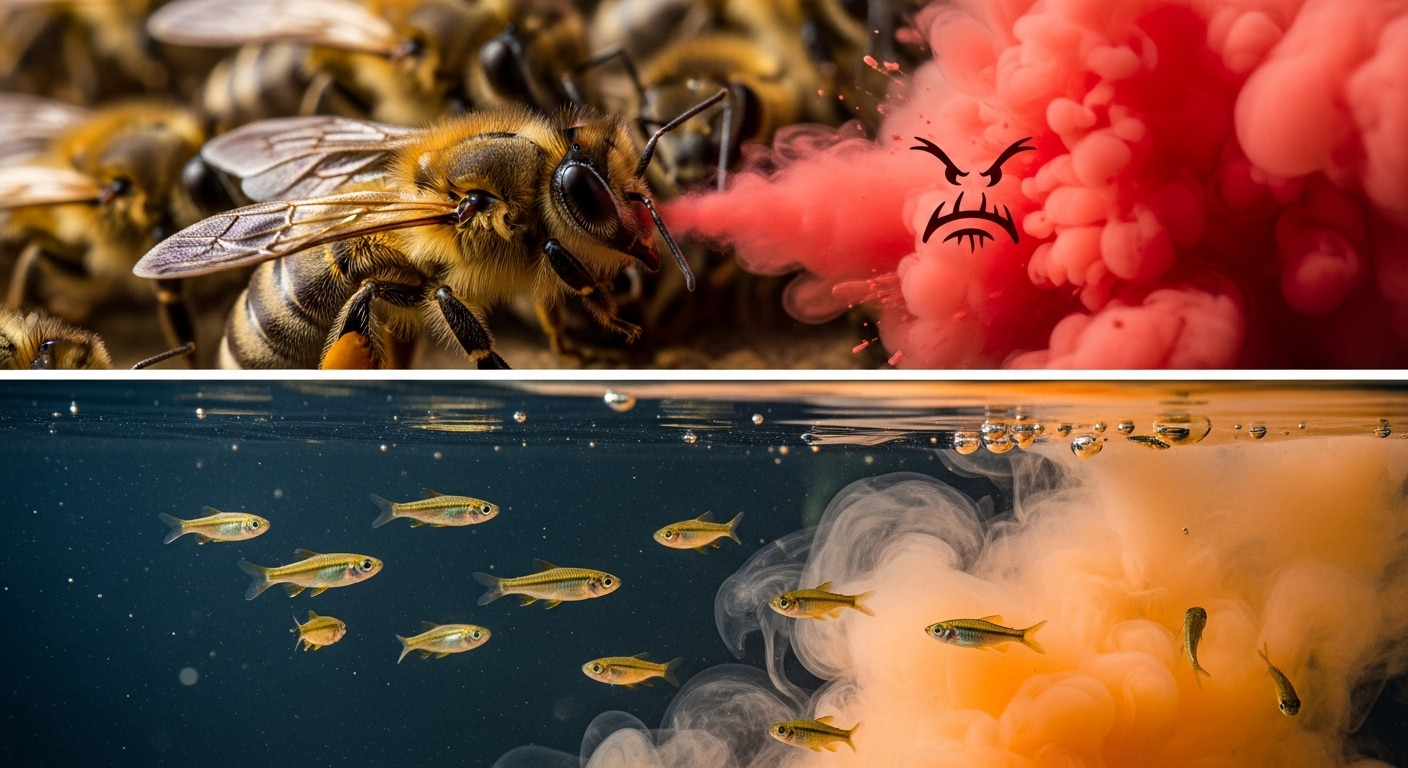Abstract: Alarm pheromones are a critical class of semiochemicals that induce immediate, stereotypical defensive or evasive behaviors in conspecifics upon exposure to threat. Unlike sex or trail pheromones, which primarily guide attraction, alarm signals are essential for group survival. This article examines the function, chemistry, and behavioral responses associated with alarm pheromones in two distinct environments: the social insect colony (honeybees) and the aquatic habitat (fish).
Alarm Signaling in Social Insects: The Honeybee Sting
In social insects, alarm pheromones are central to colony defense. When a guard honeybee stings an intruder, the detached sting apparatus releases a potent chemical blend that functions as a highly efficient alarm and recruitment signal (Free, 1987). The main component of the honeybee sting alarm pheromone (SAP) is **Isopentyl Acetate (IPA)**, a short-chain ester that has a characteristic banana-like scent to humans (Collins & Blum, 1982).
The release of SAP triggers a cascade of aggressive and defensive behaviors in nearby nestmates, including attraction to the site of the original sting and subsequent stinging (Moritz & Bürgin, 1987). The alarm signal is highly context-dependent; its presence can even interfere with other behaviors, such as suppressing a bee’s ability to learn an appetitive olfactory cue—a response that prioritizes colony defense over foraging in a crisis (Balderrama et al., 2002; Richard et al., 2010).
The Schreckstoff (Fear Substance) in Fish
In many species of ostariophysan fish (e.g., minnows, characins), the alarm signal is released upon physical injury, such as when a predator bites the skin. This substance, termed **Schreckstoff** (German for “fear substance”) by Karl von Frisch in 1938, is stored in specialized epidermal club cells (Chivers & Smith, 1998). The most active component of Schreckstoff is believed to be **hypoxanthine-3(N)-oxide** (Pfeiffer, 1978).
When the skin is broken and the chemical is released into the water, nearby conspecifics respond with immediate, innate anti-predator behaviors. These reactions can include flight, rapid schooling, seeking shelter, or freezing, depending on the species and context (Chivers & Smith, 1998). Unlike the alarm pheromone of bees, which actively recruits, the Schreckstoff signal is generally an *evasive* mechanism, causing dispersal away from the danger.
Common Traits and Functions
Despite their chemical differences and distinct environments, both the bee and fish alarm pheromone systems share key characteristics that underscore their evolutionary significance:
- **Innate Response:** The behavioral response to the chemical is typically innate and rapid.
- **Chemical Unspecialization:** Alarm pheromones tend to be less chemically specialized than sex pheromones, sometimes allowing related species to detect each other’s danger signals (Blum, 1985).
- **High Ecological Cost/Benefit:** The release of the signal (e.g., the honeybee’s fatal sting or the fish’s injury) comes at a high cost to the emitter but provides a significant fitness benefit to the group or colony.
References
Balderrama, N., et al. (2002). Alarm pheromones affect the performance of honeybee workers in the proboscis extension response assay. *Physiology & Behavior*, 77(4-5), 517–520.
Blum, M. S. (1985). Alarm pheromones. In *Comprehensive Insect Physiology, Biochemistry and Pharmacology* (Vol. 9, pp. 193–224). Pergamon Press.
Chivers, D. P., & Smith, R. J. F. (1998). Chemical alarm signalling in aquatic predator–prey systems: a review and prospectus. *Écoscience*, 5(3), 338–352.
Collins, A. M., & Blum, M. S. (1982). Bioassay of the alarm pheromone of the honeybee, *Apis mellifera*. *Journal of Chemical Ecology*, 8(2), 437–445. [Contextual reference for IPA identification]
Free, J. B. (1987). *Pheromones of Social Bees*. Cornell University Press. [Contextual reference for SAP function]
Moritz, R. F. A., & Bürgin, H. (1987). Alarm pheromones and the defense of honeybee colonies. *Journal of Chemical Ecology*, 13(4), 697–711.
Pfeiffer, W. (1978). Schreckreaktion und Schreckstoffzellen bei Ostariophysi. *Zeitschrift für Tierpsychologie*, 47(1), 101-118. [Contextual reference for Schreckstoff discovery/chemistry]
Richard, G., et al. (2010). An alarm pheromone modulates appetitive olfactory learning in the honeybee (*Apis mellifera*). *Frontiers in Behavioral Neuroscience*, 4, 157.


Leave a Reply